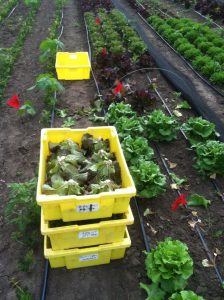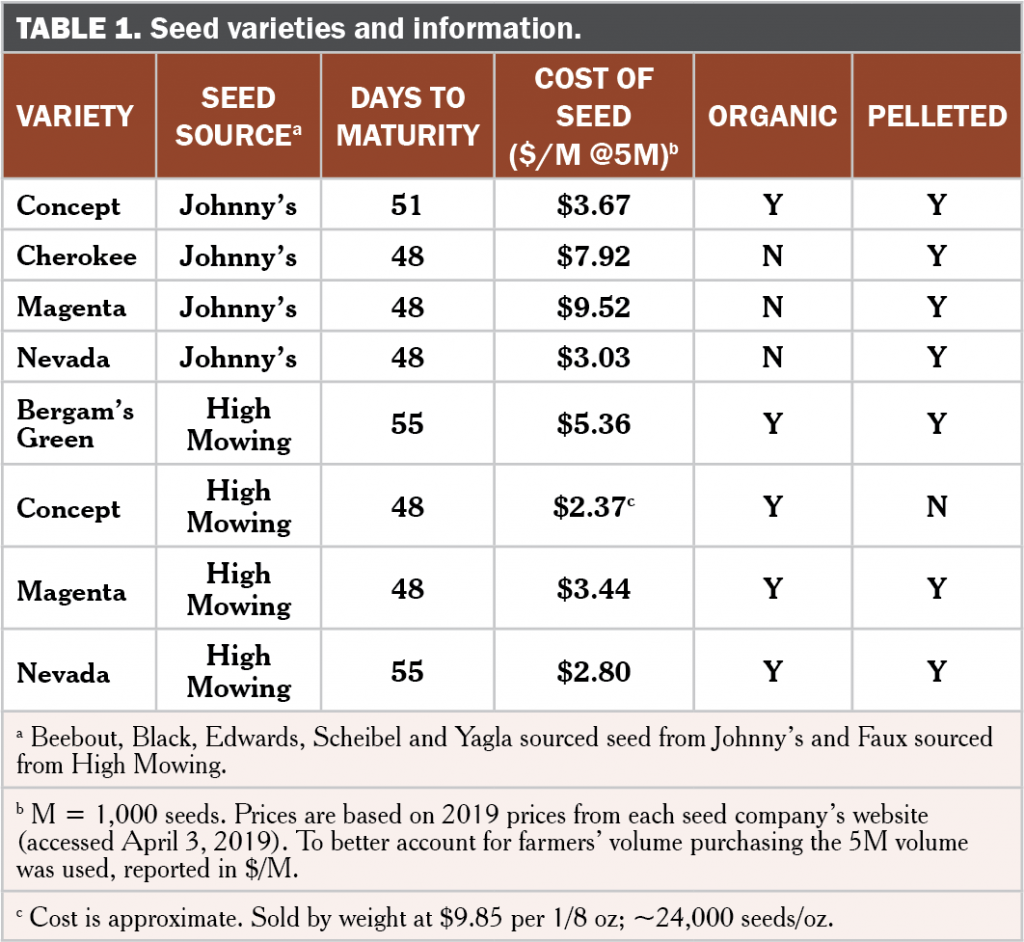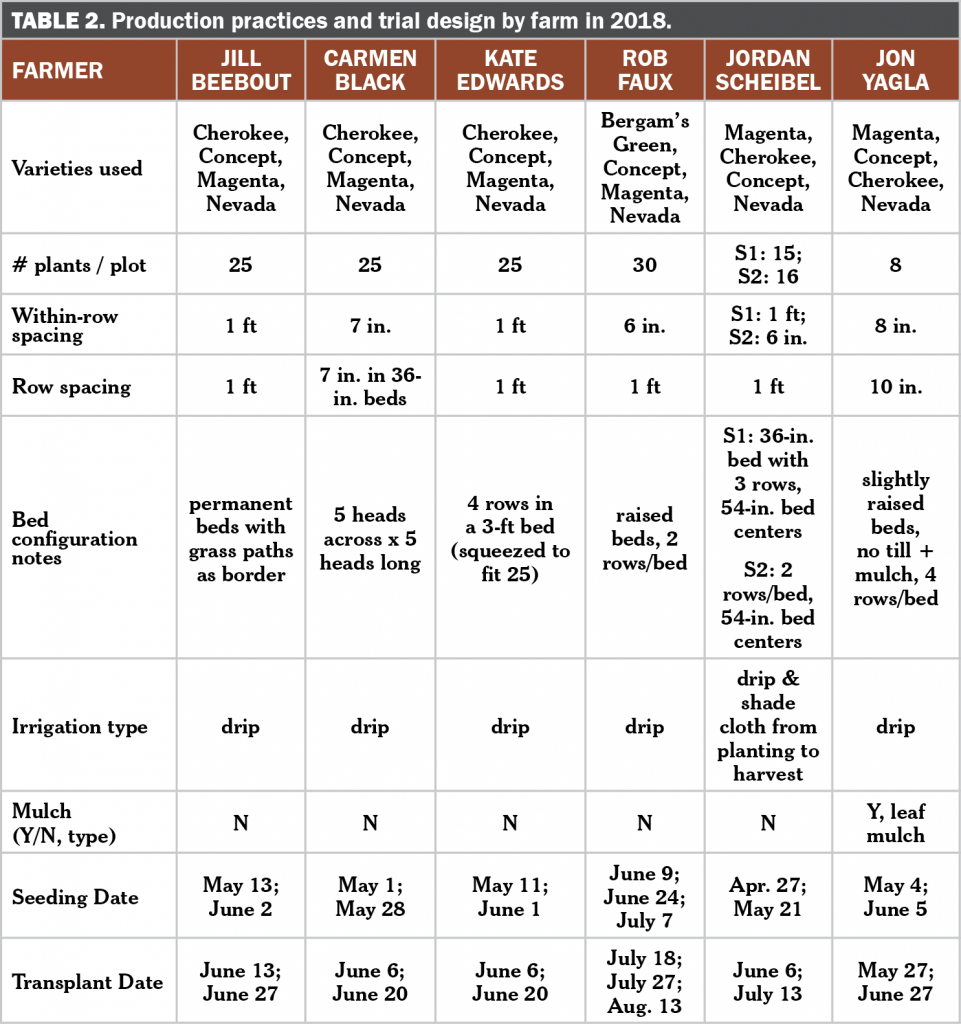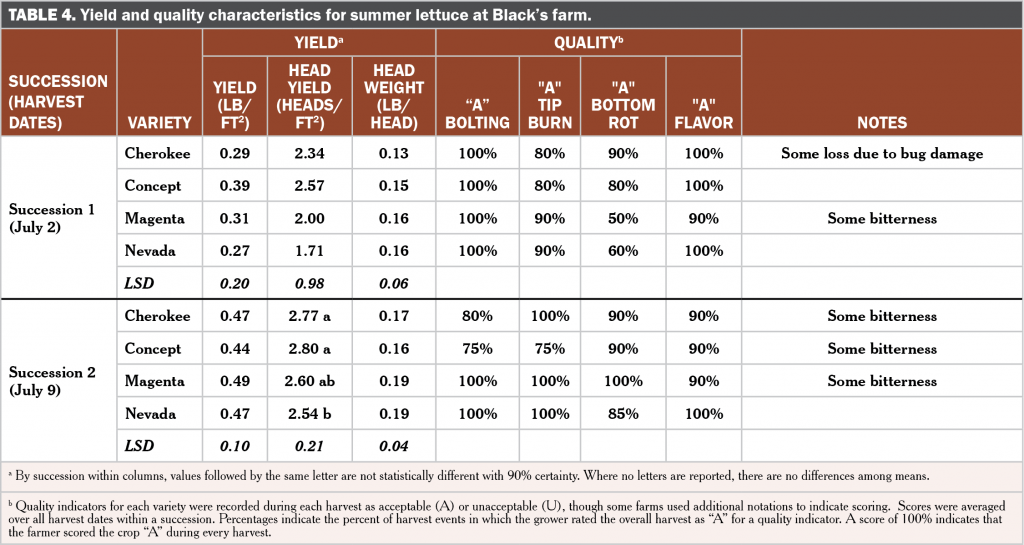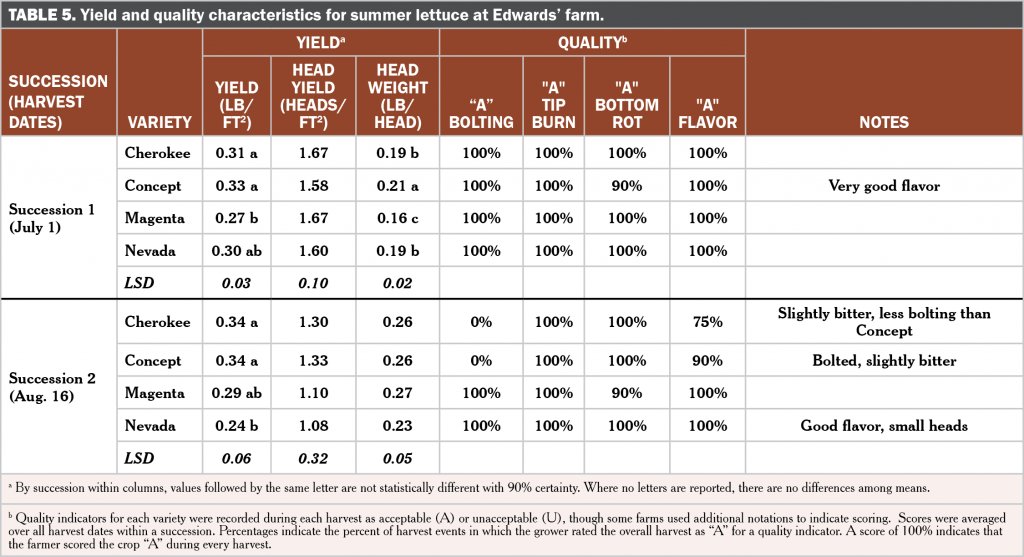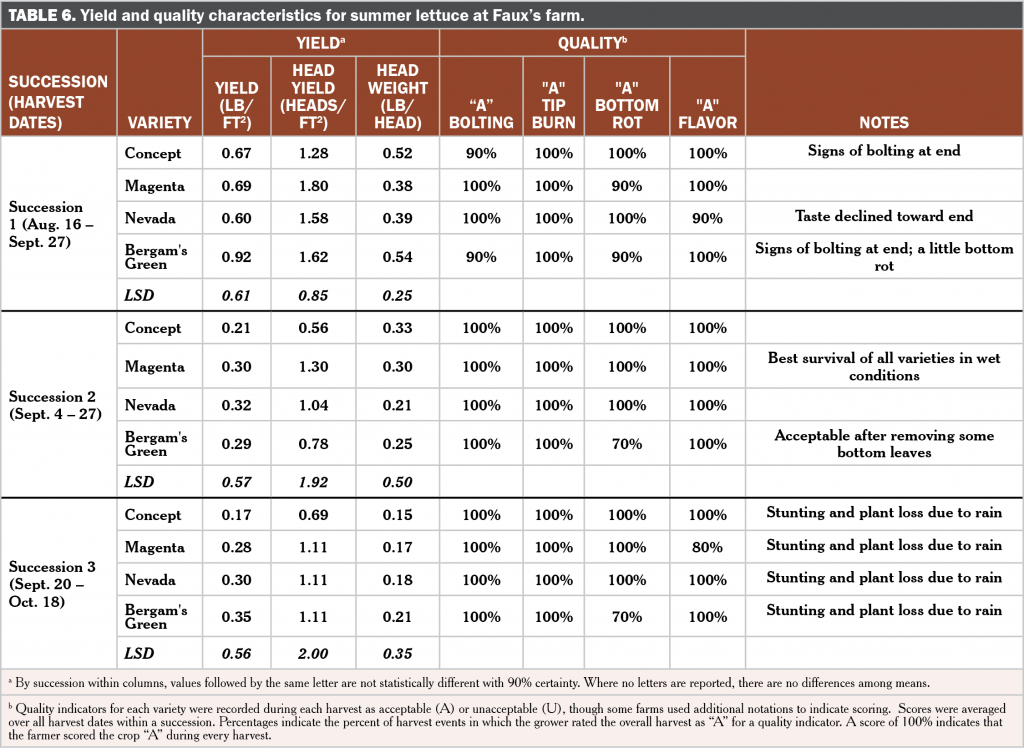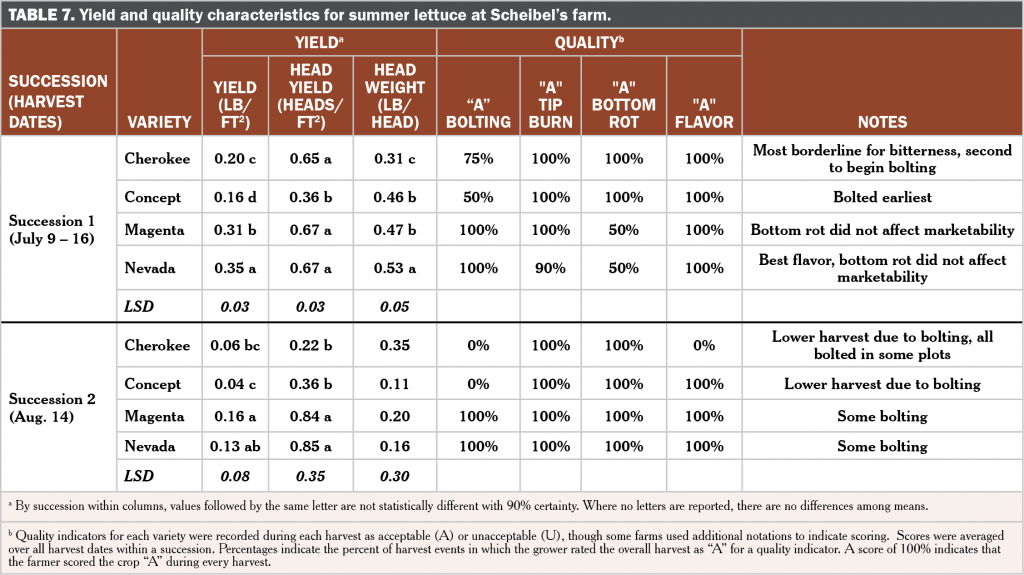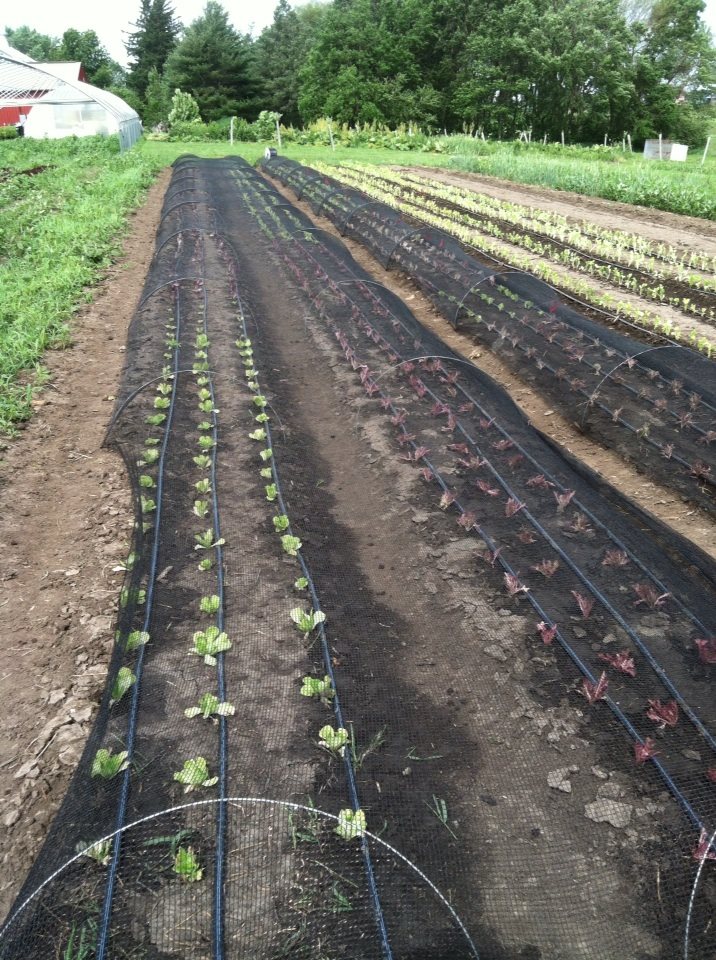In a Nutshell:
- To meet customer demand, Iowa vegetable farmers need to grow lettuce during the hot summer months when lettuce, a cool-season crop, is most difficult to grow.
- Six farmers compared four lettuce varieties – Concept, Cherokee, Magenta and Nevada – to determine which produce best during summer in Iowa.
Key findings
- Top-yielding varieties differed by farm and succession. Concept was the top-yielding variety (lb/ft2) in five of the 13 trials, though not always with statistical significance.
- Three farms reported that Nevada had the best flavor, while Cherokee was most often cited for bitterness.
Background
During the high summer of July and August, leafy greens are difficult to grow in Iowa. They bolt quickly, sending their energy, and sugars, toward reproduction. Even if greens appear marketable, they can be bitter-tasting. “It feels like there’s always a few CSA boxes in July that are difficult to fill, so having lettuce longer in the season would be really helpful to keep up the variety before the late summer crops like tomatoes and sweet corn come in,” said Carmen Black. This sentiment was echoed by Kate Edwards, who said, “Midsummer lettuce has the potential to add diversity during the summer for the CSA share.”
To meet the desires of their customers, farmers are interested in finding varieties of head lettuce that are tolerant to the heat of summer and which taste acceptable and work in their production system. In 2017, farmer-researchers in the PFI Cooperators’ Program conducted variety trials on four popular head-lettuce varieties – Coastal Star, Hampton, Magenta and Muir – and found Magenta had the greatest yields on three of the six farms and showed the greatest tolerance to heat. Coastal Star produced the largest heads but was most susceptible to bolting.[1] Specific preferences from the 2017 trials differed slightly by farm, but most farms were interested in conducting a second variety trial with Magenta and three new varieties in 2018.
Objective: Compare four lettuce varieties – Magenta, Concept, Cherokee and Nevada (one farm also included Bergam’s Green) – for differences in yield and quality characteristics.
Black said, “I look forward to narrowing in on the summer lettuce varieties that will work best in our system so we can consistently grow good-tasting lettuce throughout the summer. I’m looking forward to continuing to demonstrate to other vegetable farmers that it’s possible to grow lettuce in Iowa during July and to learn from other farmer-researchers in the project.” Jill Beebout from Blue Gate Farm added, “Last year’s lettuce trial was such a success for us, we are interested in further experimentation with more varieties. Hopefully this will lead to an increase in product and profitability for our CSA and at farmers market.”
Methods
This project was conducted by farmers at six Iowa farms: Jill Beebout (Blue Gate Farm; Chariton), Carmen Black (Sundog Farm; Solon), Kate Edwards (Wild Woods Farm; Iowa City), Rob Faux (Genuine Faux Farm; Tripoli), Jordan Scheibel (Middle Way Farm; Grinnell) and Jon Yagla (Millet Seed Farm; Iowa City).
All farmers planted four replications of four lettuce varieties in randomized, replicated trials. Five farmers trialed the varieties Cherokee, Concept, Magenta and Nevada, and one farmer (Faux) substituted Bergam’s Green for Cherokee. Varieties were selected based on farmer preference, varietal similarities and availability of organic or untreated seed. Information about each variety is available in Table 1. Seeds for the trials were provided by Johnny’s Seeds (Winslow, ME) and High Mowing Seeds (Wolcott, VT). Farmers planted at least two successions of lettuce to better account for variation in summer weather and to mimic their normal production practices for consistent supply.
Production practices including mulching, spacing, irrigation, planting dates and harvest dates were determined by farm and are detailed in Table 2. The number of plants per plot ranged from eight to 25, and spacing between rows and within rows did not exceed 1 ft on any farm. All farms transplanted lettuce to the field.
Farmers harvested and field-cleaned lettuce heads, then recorded the weight and count of marketable lettuce heads harvested per plot. During each harvest date, farmers also scored varieties as acceptable (A) or unacceptable (U) for quality indicators including bolting, tip burn, bottom rot and flavor. These scores were then averaged across harvest dates to provide a score from 0 to 100% indicating the percent of harvest events for which the variety received an “A” rating for the quality indicator (100% being all “A” ratings).
Data were analyzed using JMP Pro 13 (SAS Institute Inc., Cary, NC) statistical software. Means separation among varieties by succession at each farm was computed using Tukey’s least significant difference (LSD) to examine effects on lettuce yield. Statistical significance is reported at the 90% confidence level.
Results and Discussion
Yield across farms and successions
Mean yield by variety and succession on each farm are shown in Figure 1. Concept was the top-yielding variety (lb/ft2) in five of the 13 trials, though not always with statistical significance. In six different trials, differences in yield were statistically significant at 90% certainty. Among those six trials, the four main lettuce varieties – Cherokee, Concept, Magenta and Nevada – each achieved the highest yield during at least one trial.
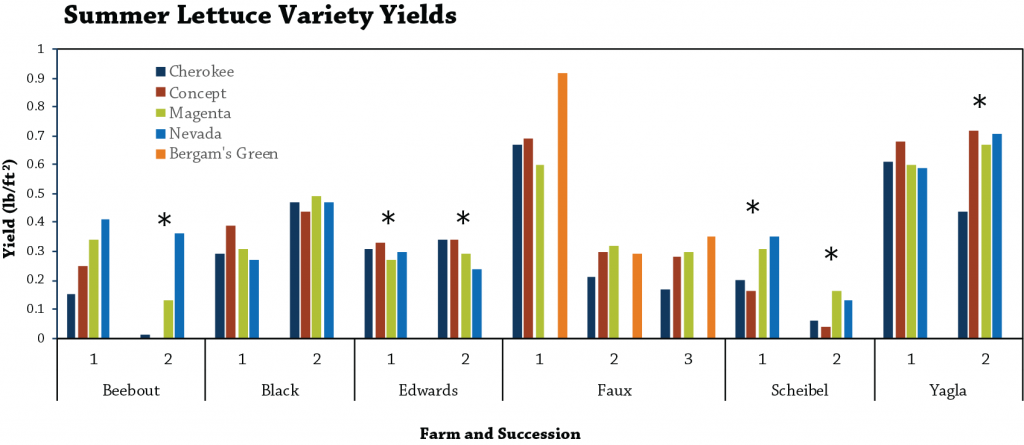
Figure 1. Summer lettuce variety yields by succession planting and farmer in 2018. Asterisks above clusters of columns indicate there were statistically significant differences in yields among varieties for that succession planting. Details of yield values and statistical significance are presented for each farm individually in tables 3-8.
Differences in yields among farms may be explained by differences in plant spacing, but additionally, some farmers prefer, or are willing, to harvest smaller heads to meet market timing restraints rather than waiting for maximum head size. Extremely low yields were typically the result of plant loss due to bolting. Cherokee and Concept were most prone to bolting.
Several farmers (Beebout, Edwards, Faux and Scheibel) noted that weather – particularly heavy rainfall – made 2018 a difficult production season (Table A1). Some farmers lost entire successions of this trial to flooding and no data were reported for those crops. Weather in 2018 was very wet, emphasized by the 14.2 in. of rain in September at Faux’s farm compared to the historical average of 3.5 in.
Top-yielding varieties and farmer preferences differed by farm and by succession on individual farms. Specific results within each farm are reported below.
Beebout, Chariton
Beebout ran two successions of the trial, which were harvested during late July and August (Table 3). Succession 2 showed some statistical differences among the varietal yields. Nevada statistically out-produced Cherokee and Magenta in lb/ft2 and heads/ft2 and out-produced only Cherokee in head weight (lb/head). There were no succession 2 plots with Concept due to poor germination. Nevada had the highest average yield in succession 1 (0.41 lb/ft2, 0.91 heads/ft2), but the differences were not statistically significant due to variation among the plot values within each variety.
Beebout noted that Cherokee had the most trouble with bolting and bitterness. During succession 2 many of the plots had bolted plants and experienced insect damage from cucumber beetles and cabbage looper larvae. She also noted that weather was the most challenging part of the trial – July at her farm was very dry (Table A1).
Black, Solon
Black planted two successions of the summer lettuce trial, which were harvested July 2 and July 9 (Table 4). She was the only farmer to run the trial in a high tunnel, with the sides rolled up at all times. This was primarily to protect the lettuce from pounding rains and soil splash. Within succession 2, there were some statistically significant differences in head yield among the varieties. Concept (2.80 heads/ft2) and Cherokee (2.77 heads/ft2) had greater head yields than Nevada (2.54 heads/ft2), but were not significantly greater than Magenta (2.60 heads/ft2). The trend was the same for succession 1, with Concept having the most head yield (2.57 heads/ft2), followed by Cherokee, then Magenta and Nevada last; however, due to variation in yield within varieties, these differences were not statistically significant.
Black noted more bolting and bitterness in succession 2, particularly for Cherokee and Concept. Nevada had the best flavor in succession 2. Black reported that she harvested all plants in succession 1 as soon as the crew noticed some tip burn and bottom rot. This led to a slightly earlier harvest than preferred, but saved the crop before it became unmarketable.

Left: Black’s summer lettuce variety trial inside the high tunnel on June 19. Right: Newly transplanted lettuce seedlings at Edwards’ farm on June 13.
Edwards, Iowa City
Edwards’ two successions of summer lettuce both showed a statistical difference in yield by variety (Table 5). In both successions, Concept and Cherokee were the greatest yielding varieties. In succession 1 Concept and Cherokee had statistically higher yields in lb/ft2 than Magenta, and Nevada was intermediate. Concept had the greatest head weight (0.21 lb/head) followed by Cherokee and Magenta (both 0.19 lb/head) and Nevada had the smallest head weight (0.16 lb/head). During succession 2, Cherokee and Concept were again the greatest yielding varieties (both 0.34 lb/ft2), but Nevada had the lowest yield (0.24 lb/ft2) and Magenta was intermediate.
Edwards did not have any issues with bolting during succession 1 and noted that Concept had the best flavor. In succession 2, she noted that Cherokee and Concept were both slightly bitter and had issues with bolting. Still, bolting did not affect yield since she harvested before bolting was a problem. Edwards noted during succession 2 that Nevada had the best flavor but the smallest heads of the tested varieties.
Faux, Tripoli
Faux’s variety trial setup was slightly different than the others – he replaced Cherokee with Bergam’s Green, ran three successions instead of two, and harvested later than any other farm (Table 6). This late harvest was due, in part, to rainy weather, as shown in Table A1. Faux recorded the overall highest yields of any farm – 0.92 lb/ft2 for Bergam’s Green during succession 1. Within each succession, there were no statistical differences in yield among varieties.
Challenging weather conditions dictated much of the harvest at Faux. Heavy rainfall in late August and early September impacted the overall quality of the lettuce. With wet soil and some standing water, the plants reverted to root development from leaf development, and Faux delayed harvest as long as possible to allow the plants to size up. Only a portion of the succession 1 harvest was of the head size desired for market. Faux said, “Most of the lettuce held well-enough in the field; Nevada and Magenta held quality the longest, but did not bulk up too much more. Concept began to give out first, and then Bergam’s Green.”
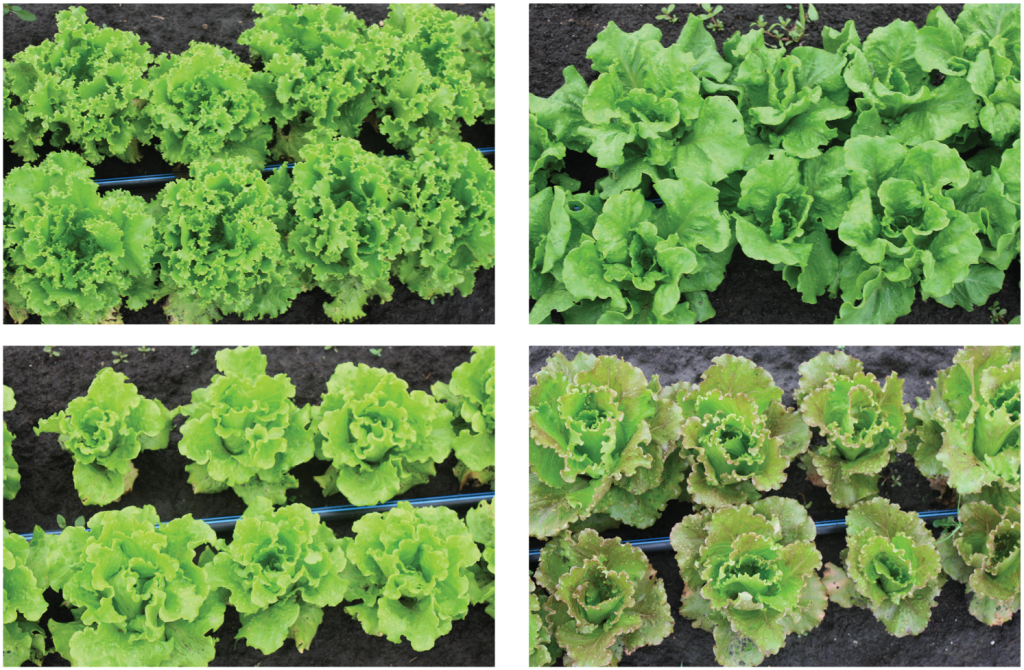
Each of the lettuce varieties grown at Faux’s farm. Clockwise from top left: Bergam’s Green, Concept, Magenta and Nevada.
CSA customers of Faux’s farm reviewed the varieties for taste. He reported, “Magenta was known to our customers and continued to receive good reviews. Concept received the best reviews for taste of the new varieties. Bergam’s Green received the most compliments for visual appeal and was well-liked for commercial kitchen customers. Nevada received the fewest positive reviews for taste, though no one tagged it as having poor taste.”
Scheibel, Grinnell
Scheibel ran two successions of the summer lettuce variety trial, harvesting succession 1 from July 9-16, and succession 2 on Aug. 14 (Table 7). Succession 2 had issues with bolting, particularly with Cherokee and Concept, but all varieties had some yield loss due to bolting.
Within each succession, there were statistical differences in yield (lb/ft2) among varieties. During succession 1, each variety was statistically different from the others. Nevada had the greatest yield (0.35 lb/ft2) followed by Magenta (0.31 lb/ft2), Cherokee (0.20 lb/ft2) then Concept (0.16 lb/ft2). Cherokee produced the smallest head compared to the other three varieties during succession 1 (0.31 lb/head), and Nevada produced the largest heads (0.53 lb/head). The head weights of Concept and Magenta were not statistically different from one another (0.46 and 0.47 lb/head). Concept bolted earliest, and thus produced fewer marketable heads (0.36 heads/ft2), compared to the other three varieties (0.65–0.67 heads/ft2).
In succession 2, Magenta and Nevada were again the top-yielding varieties. While not statistically different from each other at 0.16 and 0.13 lb/ft2, respectively, they did have statistically greater yields than Concept (0.04 lb/ft2) and Magenta yielded statistically greater than Cherokee. Cherokee and Concept lost harvest due to bolting during succession 2, which resulted in a statistically smaller head yield (0.22 and 0.36 heads/ft2) compared to Magenta and Nevada (0.84 and 0.85 heads/ft2). Although Cherokee yielded the fewest marketable heads due to heavy bolting, those that were marketable were larger than the other varieties.
Scheibel noted that Nevada had the best flavor, and that Cherokee bordered on bitterness in succession 1 and was unacceptably bitter in succession 2. More broadly, Scheibel noted that succession 1 had nearly ideal conditions for summer lettuce, while succession 2 was very hot at planting, had more weed pressure, and the irrigation was not in place at the beginning. “In some ways the difference in the successions allowed me to compare performance of the varieties in ideal conditions and disaster conditions, which was informative.” Scheibel was the only farmer who used a 30% shade cloth on his lettuce. He left the shade cloth on for the duration of the season, but next year might experiment with taking the shade cloth off after two weeks to prevent plants from stretching too much for light.
Yagla, Iowa City
Yagla evaluated two successions of summer lettuce in his no-till urban garden plots, which were mulched with leaves (Table 8). Although there was no statistical difference in yield among varieties in succession 1, Concept had the greatest values in each of the yield categories (lb/head, heads/ft2, lb/ft2). In succession 2 there was a statistical difference in yield responses among varieties. Cherokee produced the smallest heads (0.37 lb/head) and yield (0.44 lb/ft2) and the other three varieties were statistically similar to one another.
Yagla noted bitterness in all varieties in succession one and bolting in all varieties except Cherokee. He again noted some bitter flavor in succession 2. All lettuce heads harvested were of acceptable quality, though the bitterness of Cherokee in succession 1 was barely acceptable. His notes indicate Magenta had the most consistent and uniform heads and Concept was also a strong performer for quality.
Conclusions and Next Steps
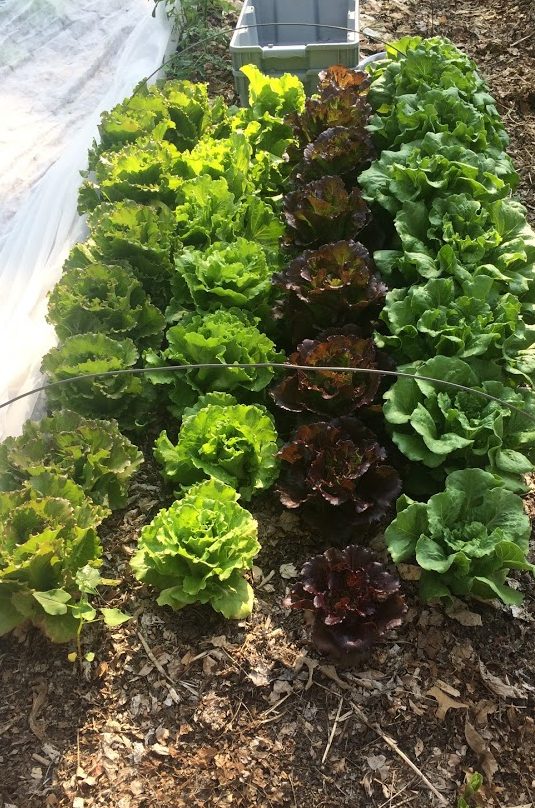
A variety trial plot at Jon Yagla’s. In the bed from left to right: Magenta, Nevada, Cherokee and Concept.
After two years of summer lettuce trials, farmers are confident that they can consistently grow lettuce through the heat of the summer with better knowledge of successful varieties. In 2017, Magenta was the favorite variety of those tested.[1] In 2018, farmers each had different preferences based on their farm’s results. Concept was the top-yielding variety (lb/ft2) in five of the 13 trials, though not always with statistical significance. In six of the trials, differences in yield (lb/ft2) were statistically significant at 90% certainty. Among those six trials, the four main lettuce varieties – Cherokee, Concept, Magenta and Nevada – each achieved the highest yield during at least one trial.
Three farmers reported that Nevada had the best flavor (Black, Edwards, Scheibel), though Concept, Magenta and Bergam’s Green were also strong performers. Customers at Faux’s, however, scored Nevada the lowest for flavor. Though the seed for lettuce production is not a significant cost, it was heartening to farmers that Nevada was one of the least expensive seeds in the trial, as shown in Table 1. Magenta was the most expensive.
In addition to careful variety selection, farmers identified proper irrigation, weed management, multiple successions and shade cloth as important factors for success. Jordan Scheibel remarked, “The trial definitely identified varieties that were superior in my growing condition and that I would consider growing again. It also reinforced how important shade cloth and irrigation are for getting a reliable summer lettuce crop.”
Carmen Black added, “This trial reaffirmed that the trick to summer lettuce, for me, is growing many successions, which can even-out the impact of extreme weather conditions. I plan to grow all these varieties again next year, only making slight adjustments to my germination strategies and growing additional successions of lettuce.”
Jon Yagla, who sells in the Iowa City market, reported the following: “Despite some bitterness in most of these head lettuces, CSA members seemed to be very pleased with having local lettuce available during the summer, especially since it was rarely available at farmer’s market at this time. I was impressed with the yields and how quickly they were ready for harvest after transplanting (about 30 days in the field). The main challenge I noticed was timing the harvest right – they go from a perfect-looking head to bolting very quickly in this heat. I will definitely continue to grow Magenta and Nevada. I will also grow Concept and Cherokee but continue to trial other varieties that may perform better. I now plan to start heat tolerant head lettuces approximately every 2 weeks throughout the season for a continuous supply throughout the summer.”
Appendix – Weather Conditions
References
- Kolbe, L., C. Black, R. Faux, A. McGary, J. Scheibel and K. Edwards. 2017. Summer Lettuce Variety Trial. Practical Farmers of Iowa Cooperators’ Program. https://practicalfarmers.org/research/summer-lettuce-variety-trial/ (accessed April 2019).
- Iowa Environmental Mesonet. 2019. Iowa Environmental Mesonet. Iowa State University Department of Agronomy. http://mesonet.agron.iastate.edu/ (accessed March 2019).


